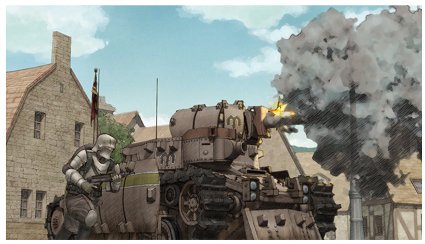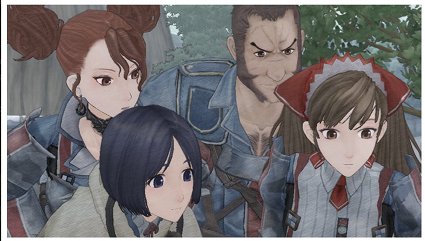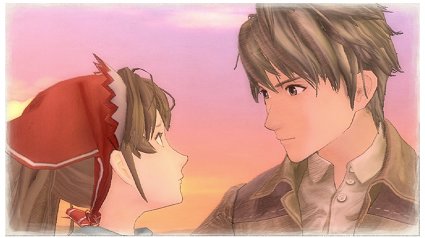I have a confession to make: Sega’s Valkyria Chronicles really isn’t a steampunk game. It’s more of an Anachronism Stew; it’s got a hearty dieselpunk base (most weapons and technology), chunks of meaty steampunk (costumes, politics, other weapons) and out-of-left-field historical anomalies (the lancer class), and is garnished with a zesty, zesty sprinkling of Japanese fascination with western dictatorships.
And it is one of the best turn-based tactical warfare games of the last five years. Personally, I haven’t liked a turn-based tactics game as much as I did Valkyria Chronicles since I first played Final Fantasy Tactics on the Playstation 1 far too many years ago.
Released in North American for the Playstation 3 in late 2008, Valkyria Chronicles portrays events in the kingdom of Gallia, a fictional Baltic state in 1930s “Europa,” that is really just the setting for an alternate history mash-up of every Eastern European war that took place between 1850 and 1945. People who have either read a book, or remember a European history class, may be slightly uncomfortable to note that the primary setting backdrop is the invasion of a peaceful, idyllic, Germanic-influenced country by the red-attired, tank-wielding invaders coming from a Russianly-direction.
….
….
So, yeah.
 Anyways, the story centers around Welkin Gunther, a bourgeois intellectual who volunteers for the Gallian militia (bringing his own tank, as a matter of fact) to help defend his homeland from the hordes of the Autocratic Europan Imperial Alliance (which doesn’t make a whole lot of sense, but just run with it). As the war continues, primarily from Welkin’s perspective, we learn that the conquest of Gallia is really secondary to the Alliance; embroiled in a much larger war of conquest with another superpower, the Alliance is searching Gallia for the remains of a much older civilization, hoping that their findings will provide them with the definitive edge they need to achieve victory for their Emperor.
Anyways, the story centers around Welkin Gunther, a bourgeois intellectual who volunteers for the Gallian militia (bringing his own tank, as a matter of fact) to help defend his homeland from the hordes of the Autocratic Europan Imperial Alliance (which doesn’t make a whole lot of sense, but just run with it). As the war continues, primarily from Welkin’s perspective, we learn that the conquest of Gallia is really secondary to the Alliance; embroiled in a much larger war of conquest with another superpower, the Alliance is searching Gallia for the remains of a much older civilization, hoping that their findings will provide them with the definitive edge they need to achieve victory for their Emperor.
 While the overplot isn’t exactly the most original ever, (Why do dead civilizations always have the best stuff?) Valkyria Chronicles’ characters really shine through. A combination of a solid script and excellent voice-acting really fleshes out all the characters, especially Welkin and his command squad. I’ve always thought of characterization in war-themed fiction to be particularly difficult; taking the time to allow characters to express their individual behavioral quirks can break the grim, gritty atmosphere that most war fiction attempts, but avoiding those developments can make your characters blur into the background as their individuality no longer matters. This game, I am happy to say, maintains the balance nicely.
While the overplot isn’t exactly the most original ever, (Why do dead civilizations always have the best stuff?) Valkyria Chronicles’ characters really shine through. A combination of a solid script and excellent voice-acting really fleshes out all the characters, especially Welkin and his command squad. I’ve always thought of characterization in war-themed fiction to be particularly difficult; taking the time to allow characters to express their individual behavioral quirks can break the grim, gritty atmosphere that most war fiction attempts, but avoiding those developments can make your characters blur into the background as their individuality no longer matters. This game, I am happy to say, maintains the balance nicely.
I personally really like the cel-shaded look pervasive in anime-style games, which really allows artists to add levels of artistic detail without having to fight with graphics-optimization limitations. The art in Valkyria Chronicles takes advantage of this to give all the game visuals a very strong pastel-and-watercolors feel, which besides being nice to look at also emphasizes the game’s theme of fighting for a life beyond the end of the war.
 Finally, we get to the gameplay, probably the strongest element of the game. Combat takes place on fixed battlefields as the story progresses, with options to replay battlefields or play special skirmish missions for experience and money. Rather than follow the established tactical wargame route and fill the game with a huge number of difficult-to-balance unit types—something which even Final Fantasy Tactics doesn’t quite manage perfectly—Valkyria Chronicles only has six unit types, or “classes” to the genre-savvy. While the use of tank units is mandatory on almost every battlefield, players have up to five extremely focused infantry classes ready to throw into battle: the scout, the shocktrooper, the lancer, the engineer, and the sniper.
Finally, we get to the gameplay, probably the strongest element of the game. Combat takes place on fixed battlefields as the story progresses, with options to replay battlefields or play special skirmish missions for experience and money. Rather than follow the established tactical wargame route and fill the game with a huge number of difficult-to-balance unit types—something which even Final Fantasy Tactics doesn’t quite manage perfectly—Valkyria Chronicles only has six unit types, or “classes” to the genre-savvy. While the use of tank units is mandatory on almost every battlefield, players have up to five extremely focused infantry classes ready to throw into battle: the scout, the shocktrooper, the lancer, the engineer, and the sniper.
As a result, players have an enormous amount of freedom in how they choose to approach each battlefield. You can dominate the field with snipers while scouts suss out enemy lines, you can lead from the front with your tanks and use your shocktroopers to roll right over the enemy, you can even use your tanks and a backup force of lancers and engineers to pin down the enemy’s mobile forces while a strike team of scouts and shocktroopers runs around the back to hit the enemy in the rear. There’s very little limitation on how you can approach each combat situation. Just make sure Welkin doesn’t die, or run out of troops, because that will be game over.
In the end, I’d say that Valkyria Chronicles is a 30 to 40-hour game experience. Folks who avoid the side-missions and experience-grinding might be able to knock it down to 20-25, but they would miss a lot of really interesting characterization and the battles will be much more difficult. No PS3? If you have a Sony PSP, you can play the similarly excellent Valkyria Chronicles 2, instead, though the sequel contains some spoilers for the first game.
David Pucik wants his own tank-garage…and his own tank. He also just launched a new blog, PowerLevelingTurtle.com, where he applies his thoughts on gaming, marketing, and the gaming industry at large.










